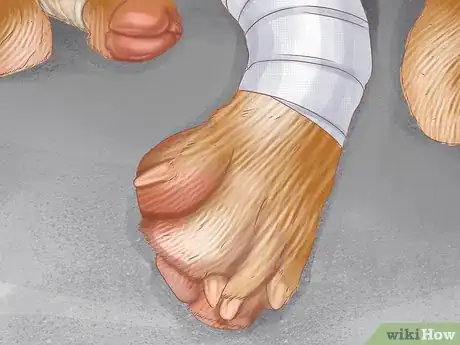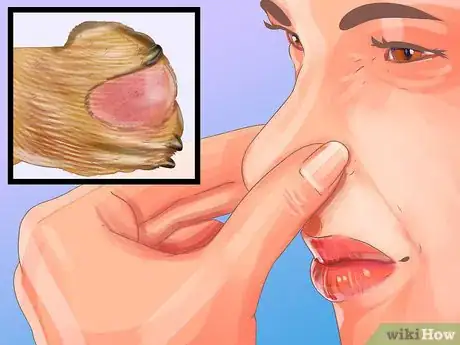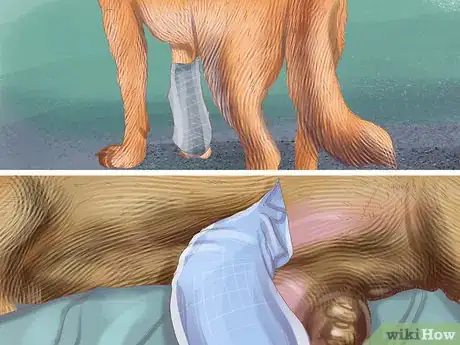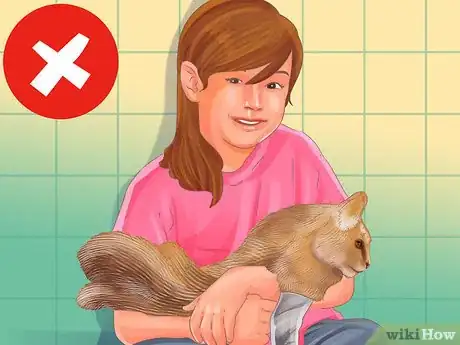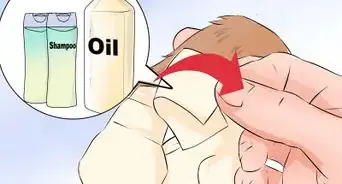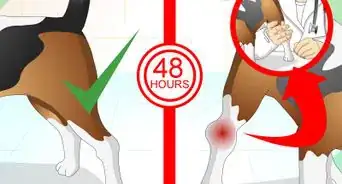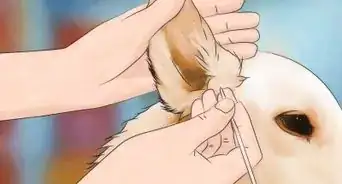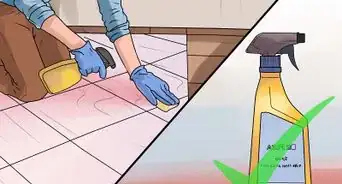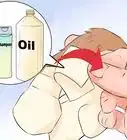This article was co-authored by Deanne Pawlisch, CVT, MA. Deanne Pawlisch is a Certified Veterinary Technician, who does corporate training for veterinary practices and has taught at the NAVTA-approved Veterinary Assistant Program at the Harper College in Illinois and in 2011 was elected to the board of the Veterinary Emergency and Critical Care Foundation. Deanne has been a Board Member of the Veterinary Emergency and Critical Care Foundation in San Antonio, Texas since 2011. She holds a BS in Anthropology from Loyola University and an MA in Anthropology from Northern Illinois University.
This article has been viewed 32,732 times.
If your pet is injured, it may need bandages to heal. When caring for your pet's bandage, you need to handle the bandage carefully. Make sure it is not too tight and have a vet change it regularly. Limit your pet's activity to promote healing and keep the bandage dry and clean. If you notice any complications with the bandage, consult a veterinarian.
Steps
Handling the Bandage
-
1Look for swelling. Swelling is easiest to see in your pet's toes. However, if a pet's bandage is not on its leg, you may notice swelling in other body parts around the bandage, like the neck.[1] There should be no signs of swelling. When toes swell, it looks as if the toes are spreading apart. This can be a sign the bandage is too tight.[2]
- If your pet's feet are swollen, see a vet to have the bandage loosened. Do not attempt to loosen the bandages yourself.
-
2Check for odor. An unusual odor coming from the cast can indicate a spreading infection. At least once a day, smell around the cast. If you notice an unusual odor, you should have this checked out by a vet.[3]Advertisement
-
3Prevent chafing with baby powder. Casts can cause chafing and discomfort for your pet. To counteract this, dust any areas where the bandage rubs your pet's skin with baby powder. Make sure you talk to your vet first, however, to make sure baby powder is safe for your specific type of pet.[4]
- If you notice a rash or other adverse reaction to the baby powder, cease use and contact a vet.
-
4Use a waterproof covering outside. It's vital to keep a bandage dry. Your vet can give you a waterproof covering to place over the cast when your pet goes outdoors. You can also wrap Saran wrap or plastic bags around the bandage and seal them with tape.[5]
- Make sure to remove the plastic covering as soon as your pet gets back inside.
- Never let a bandaged animal outside without a leash and supervision.
-
5Take your pet back to the vet if the bandage gets wet. A wet bandage needs to be replaced as soon as possible. Otherwise, the bandage can become loose or cause an infection. Inspect the bandage regularly for moisture. Take the pet back to the vet as soon as possible if you notice a damp bandage.[6]
Managing Your Pet's Activities
-
1Restrict your pet's exercise. If a pet is injured, it should not be as physically active as usual. Restrict your pet's exercise as much as possible. This will also limit damage to the bandage. Do not play with your pet while they are wounded. If you have a dog, keep walks short. For a cat, you may want to keep the cat in one small area of the home and keep it away from ledges and tables where it may jump and hurt itself.[7]
-
2Prevent chewing. A special collar or cone may be necessary to stop your pet from chewing its bandage. If your pet is having a problem with chewing, stop by your vet's office and pick up the proper equipment. Chewing can cause infections and damage to the bandage, so it's important to prevent it.[8]
- Check the bandage each day for signs of chewing. Even if your pet has not previously had a chewing issue, stress and anxiety can cause pets to begin chewing later on.
-
3Avoid slippery surfaces. You do not want a bandaged animal to overexert itself. This is especially important for bandages around the legs or feet. Keep your pet off of wood and linoleum floors as long as they are healing from the injury.[9]
- If you have a lot of wood floors in your home, lay down rugs throughout your house to help your pet walk easier.
-
4Keep your pet away from children and other animals. Not only is a bandaged pet in a weakened state, children and other animals may pull at the bandage. To keep the bandage safe from damage, limit your pet's interaction with other animals and small children until the bandage comes off. If you have more than one pet, keep the bandaged pet isolated in a room with food and water until the bandage comes off.[10]
- If you do let young children interact with the pet, monitor them closely at all times.
Consulting Your Veterinarian
-
1Talk to your vet about changing the bandage. Your vet will help you figure out an action plan for changing the bandage. The vet will tell you how often the bandage needs to be changed. Most bandages need to be changed once a week, but some may need to be changed several times each week. Ask your vet whether it's appropriate for you to change the bandage or if you should have it changed in a professional setting.[11]
- Make sure you change your pet's bandage regularly. Set a schedule in your phone or write on your calendar when you need to change your pet's bandage.
- Write down any instructions that your vet gives you. Record exactly what the vet says so that you can refer to it when you are back home.
- Ask the vet to see what the wound or incision looks like without the bandage. This will help you monitor your pet's condition. If the wound worsens, you'll be able to tell.
-
2Ask your vet how to properly change the bandage. If your vet gives you the okay to change the bandage yourself, make sure you know how to change the bandage correctly before leaving your vet's office. Bandages are changed differently depending on their type and placement. You should only change the bandage according to your vet's instructions.[12]
- While you're at the vet's office, make sure you ask any questions you have regarding changing the bandage. If your vet gives you the okay to change the bandage yourself, make sure you know how to change the bandage correctly before leaving your vet's office.
-
3Consult your vet if you notice any issues with the bandage. As soon as you notice issues, call your vet. It's very important that you not attempt to loosen or otherwise adjust the bandage yourself. This could cause injury or infection. A bandage should only be adjusted by a professional in a medical setting.[13]
- Issues that you should watch for include swollen toes, redness around the bandage, bleeding, open sores on the top or bottom of the bandage, or a bad smell. Check for these issues everyday.
- If you notice these issues, go to an emergency vet if your vet's office is not opened. Swelling and an odor can cause complications like an infection. They should be treated promptly so your pet heals as fast as possible.[14]
Expert Q&A
-
QuestionMy dog has ripped off the bandage which was covering his wound and is licking the stitches. The vet is closed until tomorrow. What should I do?
 Deanne Pawlisch, CVT, MADeanne Pawlisch is a Certified Veterinary Technician, who does corporate training for veterinary practices and has taught at the NAVTA-approved Veterinary Assistant Program at the Harper College in Illinois and in 2011 was elected to the board of the Veterinary Emergency and Critical Care Foundation. Deanne has been a Board Member of the Veterinary Emergency and Critical Care Foundation in San Antonio, Texas since 2011. She holds a BS in Anthropology from Loyola University and an MA in Anthropology from Northern Illinois University.
Deanne Pawlisch, CVT, MADeanne Pawlisch is a Certified Veterinary Technician, who does corporate training for veterinary practices and has taught at the NAVTA-approved Veterinary Assistant Program at the Harper College in Illinois and in 2011 was elected to the board of the Veterinary Emergency and Critical Care Foundation. Deanne has been a Board Member of the Veterinary Emergency and Critical Care Foundation in San Antonio, Texas since 2011. She holds a BS in Anthropology from Loyola University and an MA in Anthropology from Northern Illinois University.
Certified Veterinary Technician Your pet should not be allowed to lick the surgical incision. You should take your pet to the nearest pet emergency room so that he can be examined. It is important that your pet not bother the incision so that healing can take place.
Your pet should not be allowed to lick the surgical incision. You should take your pet to the nearest pet emergency room so that he can be examined. It is important that your pet not bother the incision so that healing can take place.
Warnings
- Unchecked bandages can be dangerous for your pet. Complications such as bacterial infection, lesions, skin wounds and blood poisoning can occur if the wound or stitches are left unchecked. Make sure you're vigilant about monitoring the bandage.⧼thumbs_response⧽
References
- ↑ https://www.petfinder.com/dogs/dog-health/banfield-pet-splint-sling-bandage/
- ↑ https://www.petfinder.com/dogs/dog-health/banfield-pet-splint-sling-bandage/
- ↑ http://www.pethealthnetwork.com/dog-health/dog-checkups-preventive-care/monitoring-dog-bandages-home
- ↑ http://www.animalcareclinicslo.com/pet-health/handouts/bandage-instructions/
- ↑ https://www.petfinder.com/dogs/dog-health/banfield-pet-splint-sling-bandage/
- ↑ https://www.petfinder.com/dogs/dog-health/banfield-pet-splint-sling-bandage/
- ↑ https://vcahospitals.com/know-your-pet/bandage-and-splint-care-in-dogs
- ↑ http://www.pethealthnetwork.com/dog-health/dog-checkups-preventive-care/monitoring-dog-bandages-home
- ↑ https://www.petfinder.com/dogs/dog-health/banfield-pet-splint-sling-bandage/
- ↑ https://www.petfinder.com/dogs/dog-health/banfield-pet-splint-sling-bandage/
- ↑ https://vcahospitals.com/know-your-pet/bandage-and-splint-care-in-dogs
- ↑ http://www.pethealthnetwork.com/dog-health/dog-checkups-preventive-care/monitoring-dog-bandages-home
- ↑ http://www.pethealthnetwork.com/dog-health/dog-checkups-preventive-care/monitoring-dog-bandages-home
- ↑ http://www.pethealthnetwork.com/dog-health/dog-checkups-preventive-care/monitoring-dog-bandages-home
About This Article
When caring for a pet with a bandaged injury, examine the bandaged limb regularly for signs of swelling, which can indicate that the bandage is too tight. If you notice swelling, ask your vet to loosen the bandage. You’ll also need to check for unpleasant odors, which may signal an infection under the bandage. Call your vet if you notice an unusual smell. To prevent chafing and irritation under the bandage, sprinkle a little baby powder in the affected area if your vet says it’s okay. It’s also important to keep the bandage dry, so put a waterproof covering over it if you plan to let your pet outdoors, and return to the vet if the bandage gets wet. Scroll down for more advice from our Veterinarian co-author, including how to manage your pet’s activity while it’s wearing the bandage.
